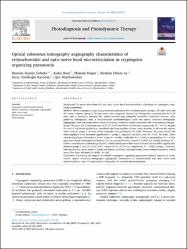Optical coherence tomography angiography characteristics of retinochoroidal and optic nerve head microcirculation in cryptogenic organizing pneumonia

View/
Access
info:eu-repo/semantics/embargoedAccessDate
2023Author
Gobeka, Hamidu HamisiBalcı, Aydın
Doğan, Mustafa
Ay, İbrahim Ethem
Yörükoğlu Kayabaş, Seray
Büyükokudan, Uğur
Metadata
Show full item recordCitation
Gobeka, H. H., Balcı, A., Doğan, M., Ay, İ. E., Kayabaş, S. Y., & Büyükokudan, U. (2023). Optical coherence tomography angiography characteristics of retinochoroidal and optic nerve head microcirculation in cryptogenic organizing pneumonia. Photodiagnosis and Photodynamic Therapy, 43, 103720.Abstract
Background: To assess retinochoroidal and optic nerve head microcirculation alterations in cryptogenic organizing pneumonia.
Methods: Thirty cryptogenic organizing pneumonia patients in the resolution phase (group 1, 30 right eyes) and 33 healthy subjects (group 2, 33 right eyes) were compared. Patients had 40 mg/day corticosteroids for 8-10 days, and a pulmonary function test, which revealed only minimally restrictive ventilation features. After gathering demographic data, a comprehensive ophthalmological exam and optical coherence tomography angiography were performed three months following maximum disease resolution with corticosteroid therapy RESULTS: Groups 1 and 2 had mean ages of 54.37±14.87 and 49.61±12.36 years, respectively (P = 0.171). Despite the lack of statistical significance, superficial and deep capillary plexus vessel densities in all macular regions were lower in group 1, as were foveal avascular zone parameters (P>0.05). However, the outer retinal and choriocapillaris flows increased significantly in group 1, especially in select areas (P<0.001, for both). There were no significant differences in whole image (P = 0.346), inside disk (P = 0.438), or peripapillary (P = 0.185) optic nerve head vessel densities between the two groups; however, nasal (P<0.001) and inferior quadrant (P = 0.006) vessel densities differed significantly. Global retinal nerve fiber layer thickness did not differ significantly between groups 1 and 2 (112.83±14.71 versus 111.45±12.74 µm, respectively; P = 0.692). Group 1, however, had significantly higher superior, nasal, and inferior quadrant, and significantly lower temporal quadrant retinal nerve fiber layer thickness (P<0.001, for all).
Conclusions: Concerning the impact of probable cryptogenic organizing pneumonia-induced hypoxia on ocular tissues, optical coherence tomography angiography assessments of retinochoroidal and optic nerve head microcirculation could be employed as a biomarker for cerebral microcirculation.















